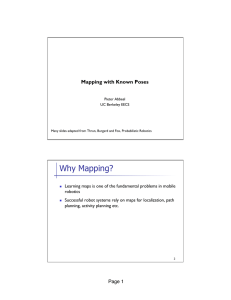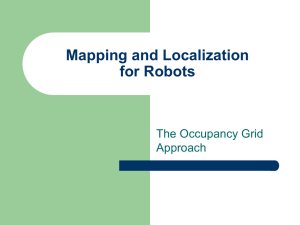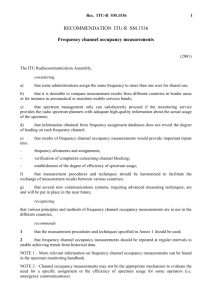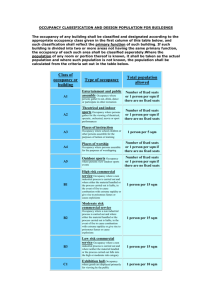Binary bayes filters and occupancy grid maps
advertisement
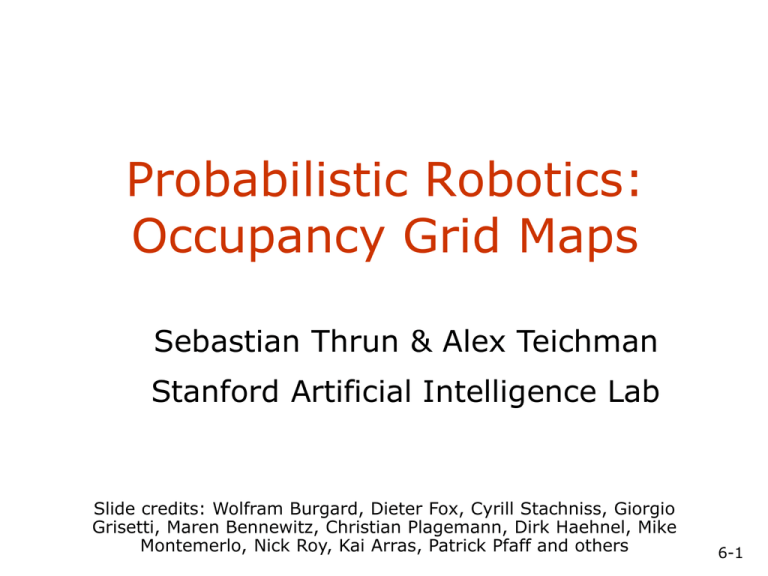
Probabilistic Robotics:
Occupancy Grid Maps
Sebastian Thrun & Alex Teichman
Stanford Artificial Intelligence Lab
Slide credits: Wolfram Burgard, Dieter Fox, Cyrill Stachniss, Giorgio
Grisetti, Maren Bennewitz, Christian Plagemann, Dirk Haehnel, Mike
Montemerlo, Nick Roy, Kai Arras, Patrick Pfaff and others
SA-1
6-1
Why Mapping?
• Learning maps is one of the
fundamental problems in mobile
robotics
• Maps allow robots to efficiently carry
out their tasks, allow localization …
• Successful robot systems rely on
maps for localization, path planning,
activity planning etc.
6-2
The General Problem of
Mapping
What does the
environment look like?
6-3
The General Problem of
Mapping
• Formally, mapping involves, given the
sensor data,
d {u1 , z1 , u2 , z2 ,, un , zn }
to calculate the most likely map
m arg max P(m | d )
*
m
6-4
Mapping as a Chicken and Egg
Problem
• So far we learned how to estimate the pose
•
•
•
of the vehicle given the data and the map.
Mapping, however, involves to
simultaneously estimate the pose of the
vehicle and the map.
The general problem is therefore denoted
as the simultaneous localization and
mapping problem (SLAM).
Throughout this lecture we will describe
how to calculate a map given we know the
pose of the vehicle. This is not the SLAM
problem.
6-5
Types of SLAM-Problems
• Grid maps or scans
[Lu & Milios, 97; Gutmann, 98: Thrun 98; Burgard, 99; Konolige & Gutmann, 00; Thrun, 00; Arras,
99; Haehnel, 01;…]
• Landmark-based
[Leonard et al., 98; Castelanos et al., 99: Dissanayake et al., 2001; Montemerlo et al., 2002;…
6-6
Problems in Mapping
• Sensor interpretation
• How do we extract relevant information
from raw sensor data?
• How do we represent and integrate this
information over time?
• Robot locations have to be estimated
• How can we identify that we are at a
previously visited place?
• This problem is the so-called data
association problem.
6-7
Occupancy Grid Maps
• Introduced by Moravec and Elfes in 1985
• Represent environment by a grid.
• Estimate the probability that a location is
occupied by an obstacle.
• Key assumptions
• Occupancy of individual cells (m[xy]) is
independent
Bel(mt ) P(mt | u1 , z 2 , ut 1 , zt )
Bel(mt[ xy] )
x, y
• Robot positions are known!
6-8
Updating Occupancy Grid Maps
• Idea: Update each individual cell
using a binary Bayes filter.
Bel (mt[ xy] ) p ( zt | mt[ xy] ) p (mt[ xy] | mt[xy1 ] , ut 1 ) Bel (mt[xy1 ] ) dmt[xy1 ]
• Additional assumption: Map is static.
[ xy]
t
Bel(m
) p( zt | m
[ xy]
t
[ xy]
t 1
)Bel(m
)
6-9
Updating Occupancy Grid Maps
• Update the map cells using the inverse
sensor model
Bel mt[ xy]
P mt[ xy] | zt ,u t 1 1 P mt[ xy]
Bel mt[xy1 ]
1 1
[ xy ]
[ xy ]
P mt
1 Bel mt[xy1 ]
1 P mt | zt ,u t 1
1
• Or use the log-odds representation
logoddsm
B m
B mt[ xy] logodds mt[ xy] | zt ,ut 1
[ xy]
t
[ xy]
t 1
B mt[ xy] : logodds(mt[ xy] )
P x
odds( x) :
1 P x
6-10
Typical Sensor Model
for Occupancy Grid Maps
Combination of a linear function and a
Gaussian:
6-11
Key Parameters of the Model
6-12
Occupancy Value Depending on
the Measured Distance
z+d1
z
z+d2
z+d3
z-d1
6-13
Deviation from the Prior Belief
(the sphere of influence of the sensors)
6-14
Calculating the Occupancy
Probability Based on Single
Observations
6-15
Incremental Updating
of Occupancy Grids (Example)
6-16
Resulting Map Obtained with
Ultrasound Sensors
6-17
Resulting Occupancy and
Maximum Likelihood Map
The maximum likelihood map is obtained by
clipping the occupancy grid map at a
threshold of 0.5
6-18
Occupancy Grids: From scans to maps
6-19
Tech Museum, San Jose
CAD map
occupancy grid map
6-20
Alternative: Simple Counting
• For every cell count
• hits(x,y): number of cases where a beam
ended at <x,y>
• misses(x,y): number of cases where a
beam passed through <x,y>
[ xy ]
Bel(m
hits(x, y )
)
hits(x, y ) misses(x, y )
• Value of interest: P(reflects(x,y))
6-21
The Measurement Model
1. pose at time t:
xt
2. beam n of scan t:
zt , n
3. maximum range reading:
t ,n 1
t ,n 0
4. beam reflected by an object:
0 1
n
m f ( xt ,n, zt ,n )
zt ,n 1
if t ,n 1
(1 m f ( xt ,n,k ) )
k 0
p( zt ,n | xt , m)
zt ,n 1
m
if t ,n 0
f ( xt , n , zt ,n ) (1 m f ( xt , n , k ) )
k 0
6-22
Computing the Most Likely Map
• Compute values for m that maximize
*
m arg max P(m | z1 ,, zt , x1 ,, xt )
m
• Assuming a uniform prior probability for p(m), this
is equivalent to maximizing (applic. of Bayes rule)
m arg max P( z1 ,, zt | m, x1 ,, xt )
*
m
T
arg max P( zt | m, xt )
m
t 1
T
arg max ln P( zt | m, xt )
m
t 1
6-23
Computing the Most Likely Map
J T N
m* arg max I ( f ( xt , n, zt ,n ) j ) (1 t ,n ) ln m j
m
j 1 t 1 n1
zt ,n 1
I ( f ( xt , n, k ) j ) ln (1 m j )
k 0
Suppose
T
N
j I ( f ( xt , n, zt ,n ) j ) (1 t ,n )
t 1 n 1
zt ,n 1
j I ( f ( xt , n, k ) j )
t 1 n 1 k 0
T
N
6-24
Meaning of j and j
T
N
j I ( f ( xt , n, zt ,n ) j ) (1 t ,n )
t 1 n 1
corresponds to the number of times a
beam that is not a maximum range
beam ended in cell j (hits(j))
zt ,n 1
j I ( f ( xt , n, k ) j )
t 1 n 1 k 0
T
N
corresponds to the umber of times a
beam intercepted cell j without ending
in it (misses(j)).
6-25
Computing the Most Likely Map
We assume that all cells mj are independent:
J
m arg max j ln m j j ln(1 m j )
m
j 1
*
If we set
j
m j
0
m j m j 1 m j
we obtain
mj
j
j j
Computing the most likely map amounts to
counting how often a cell has reflected a
measurement and how often it was intercepted.
6-26
Difference between Occupancy
Grid Maps and Counting
• The counting model determines how
often a cell reflects a beam.
• The occupancy model represents
whether or not a cell is occupied by
an object.
• Although a cell might be occupied by
an object, the reflection probability of
this object might be very small.
6-27
Example Occupancy Map
6-28
Example Reflection Map
glass panes
6-29
Example
• Out of 1000 beams only 60% are reflected from a
cell and 40% intercept it without ending in it.
• Accordingly, the reflection probability will be 0.6.
• Suppose p(occ | z) = 0.55 when a beam ends in a
cell and p(occ | z) = 0.45 when a cell is
intercepted by a beam that does not end in it.
• Accordingly, after n measurements we will have
0.55
0.45
n*0.6
0.45
*
0.55
n*0.4
11
9
n*0.6
11
*
9
n*0.4
11
9
n*0.2
• Whereas the reflection map yields a value of 0.6,
the occupancy grid value converges to 1.
6-30
Summary
• Occupancy grid maps are a popular approach to represent
the environment of a mobile robot given known poses.
• In this approach each cell is considered independently from
all others.
• It stores the posterior probability that the corresponding area
in the environment is occupied.
• Occupancy grid maps can be learned efficiently using a
probabilistic approach.
• Reflection maps are an alternative representation.
• They store in each cell the probability that a beam is
reflected by this cell.
• We provided a sensor model for computing the likelihood of
measurements and showed that the counting procedure
underlying reflection maps yield the optimal map.
6-31
